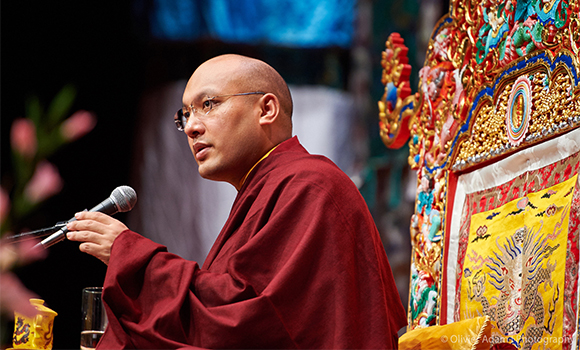May 21, 2016 -Geneva, Switzerland
In the morning session, the Gyalwang Karmapa had focused on the need to turn our minds inwards in order to find contentment and peace and had suggested that meditation was a tool for achieving this. In the afternoon session, His Holiness used his own life story as an illustration of the dangers inherent when we focus our happiness on the fulfilment of our desires and expectations; we end up being controlled by the events in our lives. What is necessary is to develop inner peace and contentment.
Teachings on Meditation by Karmapa
As a young boy he lived in Kham “as an ordinary child, nothing very special,” he explained. “When I was seven years old, a search party came looking for the Karmapa. They concealed their purpose at first and pretended to be searching for a relative, asking the names of my father and mother. Then they came a second time and told my parents that they had identified me as the Karmapa. Everyone was shocked because I was seen as just an ordinary little boy. People said that there had been some auspicious signs when I was born, so they thought I might be a tulku, but nobody thought I could be the Karmapa.”
He was happy at first. His initial expectation was that he would get new toys and many friends to play with. “I was only a child, and I thought like a child,” he commented, but he was to be disappointed. When he arrived at Tsurphu Monastery and saw the crowds of people waiting expectantly to see him, he began to have doubts. He was more than a thousand kilometres from home, clothed in ceremonial dress and riding a horse, as he entered Tsurphu to the sound of Tibetan great horns.
Once settled into his room, which served as bedroom, living room and classroom, he was looked after by senior monks in their 40s and 50s. There were no young people to play with, and instead, he spent most of the day in study, including three hours learning texts and prayers by heart. It was a very traditional education to prepare him for his future role. However, like any highly intelligent young boy he could be mischievous, and sometimes, when the teacher momentarily left the room, he would change the hands on the clock so that the lesson ended fifteen or twenty minutes early. “The teacher would return and marvel at how quickly the time had gone,” the Karmapa chuckled.
At the age of fourteen, he fled to India, leaving behind his parents and family, his monastery, his friends, and the life he knew. Reflecting on the way his life in India had unfolded thus far in ways he had not expected, the Karmapa concluded, “I think we have to regulate our wishes and expectations so as not to be controlled by what we want to happen, but rather we should be content with what we have.”
A question and answer session followed. The first questioner asked whether it was important to teach meditation to children, and how it should be done. His Holiness replied that research in the U.S.A. and the U.K. had shown that it was beneficial for children to learn to meditate, as it helped their concentration and their ability to relax. There were very simple techniques focused on outer objects, which could be used to introduce children to meditation, such as carrying on a very full bowl of water in their hands.
The second question concerned methods for dealing with afflictive emotions, which disturb our mind during meditation. His Holiness suggested that we can become aware of these emotions, such as anger and desire. When they arise, we do not follow after them but simply watch them. Since they have no real basis, there is nothing to search for and find. Simply looking at them diminishes their strength.
Next came a question about the Karmapa’s crown. From the time of Dusum Khyenpa, the Karmapas had worn the Black Hat, which was actually not black but dark blue, symbolizing the unchanging quality of space, and by extension, indicating that the nature of the dharmata, or the nature of all phenomena, does not change. The special black crown used in the Black Crown Ceremony was brought to India by His Holiness the Sixteenth Karmapa and is now at Rumtek in Sikkim.
The fourth question asked about the benefits of sadhana or yidam deity practice. His Holiness explained that the purpose of such practices is to attain the state and the special qualities of the deity invoked. It is not that we should become a different person; we practice to find the essential nature of who we are. Sadhana practice brings together all the stages of a practice, including the preliminary prayers of refuge and bodhicitta, the main practice including mantra repetition, and the final dedications.
In response to another question, His Holiness asserted that mindfulness practice without a spiritual lineage could be of benefit, but the full power and profundity of mindfulness practice was only transmitted through a lineage.
As to the quickest way to purify negative karma, His Holiness responded that, generally, in order to purify negative actions we should have a sense of shame. We need to know and acknowledge that we have committed a misdeed. Although both mantra recitation and yidam purification practices exist, because of the nature of impermanence, we also have the ability to effect a change moment by moment; the past is not the same as the future. If we have done something negative and immediately realise it, feeling shame and regret, we can purify misdeeds.
Asked to clarify the difference between interdependence and karma, the Karmapa said that the former is connected with the Buddhist view of the world (seeing that everything relies on something else), whereas the latter is focused on the behaviour of the individual. The actions of the individual have an impact on the world around them, so we have a moral responsibility; however, this responsibility must stem from the motivation of compassion.
The Gyalwang Karmapa spoke briefly of the connection between previous Karmapas and the Nyingma tradition. Both the First Karmapa Dusum Khyenpa and the Second Karmapa Karma Pakshi came from Nyingma families, and Karmapa Rangjung Dorje held the lineage of the Nyingma Nyingthik. When he was a child, the Karmapa had been encouraged to recite the Seven-Line Prayer to Guru Rinpoche, and later he had hoped to receive the Nyingthik lineage from Chatral Sangye Dorje Rinpoche but it had not been possible.
In response to a question about Buddhist engagement in politics, the Karmapa stated that there were no fundamental objections to Buddhists engaging in political activities, but the key issue was motivation. He cited His Holiness the 14th Dalai Lama as the supreme example of someone who had had to engage in politics because of his great responsibility for the welfare of the Tibetan people. If the motivation is purely to benefit others, there is no reason not to engage in politics.
With this, the afternoon session concluded and the Karmapa left for his next engagement, a meeting with members of the Tibetan community.



